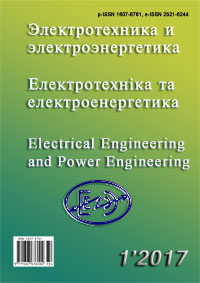LONG-TERM ELECTRICAL STRENGTH OF POLYMER FILMS UNDER THE ELECTRICAL FIELD INFLUENCE
DOI:
https://doi.org/10.15588/1607-6761-2017-1-2Keywords:
electrical strength, polymer insulating films, electric field intensityAbstract
Purpose – to study the durability of polymer films in electric field of direct current , define the type of the process of polymer films’ electric destruction under conditions of partial discharge suppression.Research methods – experimental, results were processing by means of mathematical statistics.
The results – the electrical durability of micron thickness polymer films exponentially decreases with increasing of average field strength. Evaluation of studied polymer films’ electric strength based on the definition of their longevity allow to considered polypropylene film as the most electrically strong in these testing conditions.
Scientific novelty – experimentally was determined kinetic type of various polymeric dielectrics films’ electrical aging in electric field of direct current in terms of partial discharge suppression.
The practical significance – data on breakdown strength and durability of polymeric insulating films are useful for evaluating the efficiency limit of power capacitors and other devices with polymer dielectric films, forecasting the duration of their operability.
References
Kuchinskij, G. S. (1979). Chastichnye razryady v vysokovol’tnyh konstrukciyah. Moscow: Energiya, 224.
Kojkov, S .N., Cikin, A. N. (1968). Elektricheskoe starenie tverdyh diehlektrikov i nadezhnost’ diehlektricheskih detalej, Sankt-Peterburg, EHnergiya, 186.
Elektricheskie svojstva polimerov. (2007). Pod. red. B.I. Sazhina, Sankt-Peterburg, Himiya, 192.
Dissado, L. A., Fothergill, J. S. (1992). Electerical Degradation and Breakdown in Polymers. London, Peter Peregrinus, 456.
Weber, W. (1933). Durchschlad von Paraffin. Archiv fur Elektrotechnic, 27(7), 511–522.
Borisova, M .E., Koykov, C. H., Opoc, Ya. (1982). Zakonomernosti elektricheskogo stareniya polietilenovoy kabelnoy izolyatsii pri otsutstvii chastichnyih razryadov. Elektrichestvo, 12, 58–59.
Berezhanskiy, V. B., Gorodov, V. V., Zakrevskiy, V. A., Rud, V. I. (1990). Predelnyie harakteristiki emkostnyih nakopiteley energii s plenochnyimi polimernyimi dielektrikami. Elektrotehnika, 7, 27–30.
Ushakov, V. Ya., Robezhko, A. L., Efremova, G. V. (1984). Zakonomernosti razrusheniya polimerov pri dlitelnom nagruzhenii elektricheskim polem. FTT, 26, 1, 45–49.
Malyushevs’ka, A. P., Toporov, S. O. (2016). Vpliv skladu і morfologіji kondensatornih polіmernih plіvok na termostabіl’nіst’ jih korotkochasnoji elektrichnoji mіcnostі. Elektrotekhnіka ta elektroenergetika. 1, 18–24. DOI: http://dx.doi.org/10.15588/1607-6761-2016-1-3.
Luscheykin, G. A. (1988). Metodyi issledovaniya elektricheskih svoystv polimerov. Moscow, «Himiya», 160.
Koritskogo, Yu. V., Pasyinkova, V. V., Tareeva, B. M. (1987). Spravochnik po elektrotehnicheskim materialam. V 3t, Moscow, Energoatomizdat, 2, 467.
Ushakov, V. Ya. (1988). Elektricheskoe starenie i resurs monolitnoy polimernoy izolyatsii. Moscow, Energoatomizdat, 152.
Kaush, G. (1981). Razrushenie polimerov. Moscow, Mir, 440.
Artbauer, J. (1996). Electric strength of polymers. Journal of Physics (D), 29, 446–456.
Kao, K. C. (1984). New Theory of electrical discharge and breakdown in low-mobility condensed insulators. Journal of Applied Physics, 55(3), 752–755.
Emmanuel, N. M., Knorre, D. R. (1984). Kurs himicheskoy kinetiki. Moscow, Vischa shkola, 201.
Downloads
Published
How to Cite
Issue
Section
License
Copyright (c) 2017 A. P. Malyushevska, S. O. Toporov, V. І. Gunko

This work is licensed under a Creative Commons Attribution 4.0 International License.
Creative Commons Licensing Notifications in the Copyright Notices
Authors who publish with this journal agree to the following terms:
Authors retain copyright and grant the journal right of first publication with the work simultaneously licensed under aCreative Commons Attribution License that allows others to share the work with an acknowledgement of the work's authorship and initial publication in this journal.
Authors are able to enter into separate, additional contractual arrangements for the non-exclusive distribution of the journal's published version of the work (e.g., post it to an institutional repository or publish it in a book), with an acknowledgement of its initial publication in this journal.
Authors are permitted and encouraged to post their work online (e.g., in institutional repositories or on their website) prior to and during the submission process, as it can lead to productive exchanges, as well as earlier and greater citation of published work.

